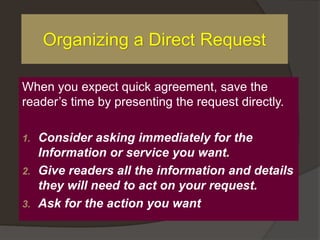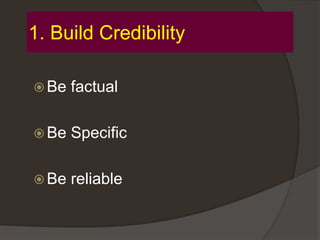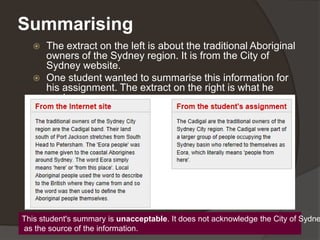LIB300_Persuasive messages s
- 2. Persuasive messages include: Orders and requests Proposals and recommendations Sales and fund-raising letters Job application letters Reports, if they recommend action Efforts to change people, such as collection letters, criticisms or performance appraisals, public services ads, etc.
- 3. Primary Purpose To have the reader act To provide enough information so that the reader knows exactly what to do. To overcome any objections that might prevent or delay action
- 4. Secondary Purpose To build a good image of the writer To build a good image of the writer’s organization To cement a good relationship between the writer and reader. To reduce or eliminate future correspondence on the same subject so the message doesn’t create more work for the writer.
- 5. What is the best subject line for a persuasive message? For direct requests, use the request, the topic, or a question Subject: Request for Updated Software Do We Need an Additional Training Session in October? For problem-solving messages, use a directed subject line or a reader benefit Subject: A Proposal to Change the Formula for Calculating Retiree’s Benefits Arguments for Expanding the Marysville Plant
- 6. How should I organize persuasive messages? In direct requests, start with the request. In a problem-solving message, start with the problem you share.
- 7. Organizing a Direct Request Request for Action Details Request for Action
- 8. When you expect quick agreement, save the reader’s time by presenting the request directly. 1. Consider asking immediately for the Information or service you want. 2. Give readers all the information and details they will need to act on your request. 3. Ask for the action you want Organizing a Direct Request
- 9. Writing Direct Request Indirect request: Is there a new version of the 2008 Accounting Reference Manual? Direct request: If there is a newer version of the 2008 Accounting Reference Manual, please send it to me.
- 10. Organizing Problem-Solving Messages - use this pattern of organization when you expect resistance from your reader but can show that doing what you want will solve a problem you and your reader share.
- 11. Organizing Problem-Solving Messages Shared Problem Details Solution Negatives Reader Benefits Request for Action
- 12. Organizing Problem-Solving Messages 1. Describe the problem you both share (which your request will solve). - Present the problem objectively and don’t assign blame or mention personalities. 2. Give details of the problem. - Be specific about the cost in money, time, lost goodwill and so on. - You have to convince readers that something has to be done before you can convince them that your solution is the best one.
- 13. Organizing Problem-Solving Messages 3. Explain the solution to the problem. If you know that the reader will favor another solution, start with that solution and show why it won’t work before you present your solution. Present your solution without using I or my. 4. Show that any negative elements (cost, time, etc.) are outweighed by the advantages.
- 14. Organizing Problem-Solving Messages 5. Summarize any additional benefits of the solution. Can be presented briefly since you described the problem in detail. 6. Ask for the action you want. Often your reader will authorize or approve something; other people will implement the action. Give your reader a reason to act promptly
- 15. What other techniques can make my messages more persuasive? Build credibility Build emotional appeal Use the right tone Offer a Reason for the Reader to Act Promptly
- 17. 1. Build Credibility Be factual Be Specific Be reliable
- 18. 2. Build Emotional Appeal Stories and psychological description are effective ways of building emotional appeal. Recent research suggests that stories are more persuasive because people remember them.
- 19. 3. Use the Right Tone Avoid messages that sound parental or preachy. Parental: Everyone is expected to comply with these regulations. I’m sure you can see that they are commonsense rules needed for our business. Better: Even on casual days, visitors expect us to be professional. So leave the gym clothes at home!
- 20. Arrogant: Based on this evidence, I expect you to give me a new computer. Better: If department funds permit, I would like a new computer. Stuffy: It is requested that you approve the above-mentioned action. Better: Please authorize us to create a new subscription letter. Passive verbs and jargons sound stuffy. Use active imperatives --- perhaps with ‘Please” --- to create a friendlier tone.
- 21. 4. Offer a Reason for the Reader to Act Promptly Show that time limit is real. Show that acting now will save time or money. Show the cost of delaying action.
- 22. Developing Marketing and Sales Messages 1. Assessing Audience needs 2. Analyzing your competition 3. Determining Key Selling Points and Benefits 4. Anticipating Purchase Objections 5. Creating a Persuasive Appeal
- 23. Creating a Persuasive Appeal Getting Attention – use a wide range of techniques to attract audience’s attention: A strong product feature or benefit A piece of genuine news A personal appeal to the reader’s emotions and values The promise of insider information The promise of savings A sample of demonstration of the product A solution to a problem. A I D A model
- 24. Building Interest - expand on and support the promises in your attention-getting opening
- 25. Increasing Desire Add details and audience benefits to increase desire for the product or service. Use strong, colorful language without overdoing it to keep readers interested.
- 26. Motivating Action Persuade the reader to take the preferred action Put a deadline on the offer, or simply remind members that the sooner they order the sooner they’ll be able to enjoy the product’s benefits. Make the task of responding as simple as possible.
- 27. Credibility • credible (adj.): believable, trustworthy • credibility (n.): integrity, reliability • incredulous (adj.): unbelievable, unreliable A business proposal must have multiple credible sources as your opposition will attempt to destroy your credibility and prove your statements incredulous.
- 28. Review: When do write persuasive messages? What is the primary purpose of it? What techniques do we use?
- 30. Are you credible? Do you appear trustworthy? Do you appear dynamic and excited about your proposal? Do you have expertise and knowledge? Will your audience identify with your message?
- 31. Evaluating Internet Sources Top level domains that provide useful clues about a site’s focus and function: .com - A commercial site. The primary function is to make money. .edu - A site affiliated with an educational institution. .gov - A government site. It presents trustworthy information (statistics, facts, reports), but the interpretive materials may be less useful. .mil - A military site. The technical information on these sites is consistently useful, but interpretive material tends to justify a single, pro-military position.
- 32. Evaluating Internet Sources .museum - can be either nonprofit or for- profit institutions, consider the purpose that the particular museum serves. .org - An organization site. Because organizations seek to advance political, social, financial, educational, and other specific agendas, review these materials with care.
- 33. APA (American Psychological Association) Style All citations should come in the form of an “APA citation sandwich”: Signal phrase + + citation For example: According to Robbins (2010), President of Travel Trends, Inc., a market research company specializing in the tourism industry, in some popular resort towns the hotel vacancy rate for the week of Christmas 2009 was 35% higher than in 2008. Robbins claims that “doing well” in the recession often just means staying afloat in whatever way possible. (para. 3). research (quote or paraphrase)
- 34. A direct quotation from a source A summary of the source or a particular section of the source Your comments on, or reactions to, the source
- 35. Quoting and Paraphrasing All research papers contain information from other sources. When you use information that has been previously published by someone else, it is important that you avoid plagiarism – presenting someone else's ideas as your own. (Plagiarism is not just cheating; it is also stealing.)
- 36. direct quotes When you use a direct quote, you copy and reference the exact word/s of the author into your writing. A direct quote may be: One word A phrase or part of a sentence A sentence A group of sentences
- 37. Exercise 1: Identifying direct quotes Read this paragraph and note the direct quotes:
- 39. For ALL quotes: Use the exact words of the author Make sure your quotation blends with the sentence Use strong or weak author to acknowledge the source Use reporting words or phrases to integrate the quote into your writing Reference your source of information
- 40. Acceptable/unacceptable quotes One student read Graddol's article and wanted to use Graddol's ideas in her assignment. The extract on the right is what she wrote. The student's writing is unacceptable. She has copied the last part of the sentence word for word.
- 41. Her second attempt The student's writing is still unacceptable. This time she has used quotation marks but she has not quoted accurately. Her third attempt This time the student has quoted correctly, because she • used quotation marks • copied the exact words • gave reference details.
- 42. Short Quotations (Less Than 40 Words): A large portion of the internet cannot be accessed through Google. In fact, no search engine “comes even close to indexing all the pages on the web” (Lucas, 2001, p. 28).
- 43. Long Quotations (40 Words or More): Morrison (1998) uses specific details to draw the reader into the scene: Three cars, say, a ’53 Bel Air, green with cream- colored interior, license number 085 B, six cylinders,double molding on rear fender pontoon, Powerglide two- speed automatic transmission; and say a ’49 Dodge Wayfarer, black, cracked rear window, fender skirts, fluid drive, checkerboard grille; and a ’53 Oldsmobile with Arkansas plates. The drivers slow down, put their heads out the windows and holler. Their eyes crinkled in mischief the drove around the girls, making U-turns and K’s, churning up grass seed in front of the houses, flushing cats in front of Ace’s Grocery Store. Circling. (p. 12-13) While the details of this passage are rich and accurate, they are not clichéd.
- 44. Paraphrasing One student wanted to use John Lennon's ideas in his assignment. The extract on the right is what he wrote. The student's writing is unacceptable. He has quoted John Lennon word for word without quotation marks. It is insufficient to simply provide a reference without also indicating that words are a quotation.
- 45. His lecturer told him he should paraphrase Lennon (change Lennon's words), so this is what he wrote. The student's writing is still unacceptable. He has changed som words, but the structure of the sentences is the same.
- 46. He tried again. When you paraphrase someone else's information or ideas, you should • keep the meaning • change the word order • change most of the words • give reference details.
- 47. Practice
- 48. Summarising The extract on the left is about the traditional Aboriginal owners of the Sydney region. It is from the City of Sydney website. One student wanted to summarise this information for his assignment. The extract on the right is what he wrote. This student's summary is unacceptable. It does not acknowledge the City of Sydne as the source of the information.
- 49. He tried again. Now the student's writing is acceptable. He has acknowledged the City of Sydney is the source of this information.
- 50. When you summarise someone else's information or ideas, you should keep the author's main ideas avoid simply copying the author's words make it clear which ideas are the author's and which are your own give reference details.
- 51. Practice
- 52. Referencing The extract on the left was written by Manktelow and published in The Sydney Morning Herald in 2006. One student read Manktelow's article and wanted to use some of his information in his UTS assignment. The extract on the right is what he wrote. The student's writing is unacceptable. He has summarised what Manktelow w but he has not acknowledged the source of the ideas.
- 53. He tried again. Now the student's writing is acceptable. He has provided all the information that is necessary in the body of his assignment. He will write the full details for the reference in a list at the end of the assignment along with all the other references he has used.
- 54. When you are referring to someone else's ideas in your writing, you should make it clear which ideas are the author's and which are your own give the author's surname give the year of publication give the page number (unless you are referring to ideas presented in the publication as a whole).
- 55. In-Text Citation Paraphrase Maracana, located in Rio de Janeiro, is the largest soccer stadium in the world (Luxner, 2005). Quote from a Source with Page Numbers At least one study has shown that “the genetic architecture of basal female mating discrimination is different from that of reinforced mating discrimination” (Ortiz- Barrientos, Counterman, & Noor, 2004, p. 2261).
- 56. Quote from a Source with No Page Numbers As Gibbs & Soares have stated, “an influenza pandemic, by definition, occurs only when the influenza virus mutates into something dangerously unfamiliar to our immune systems and yet is able to jump from person to person through a sneeze, cough or touch” (2005).
- 57. Quote from a Source with No Page Numbers & No Author Listed The logging of forest biomes has resulted in “hundreds of species of plants and animals disappearing from the planet on a daily basis” (Forest biomes, 2002).
- 58. Source with an Organization as Author “Traumatic brain injury (TBI) … occurs when a sudden trauma causes damage to the brain” (National Institute of Neurological Disorders and Stroke [NINDS], 2005). Such an injury could result from an automobile collision, a fall, or a sports accident. Any person who has suffered a blow to the head and is showing symptoms of more than mild TBI should be rushed to the hospital. While there are few cures for TBI, immediate medical attention can prevent further injuries (NINDS, 2005).
- 59. Personal Communication Dr. J. R. Thompson of the University of Tennessee confirmed by email that superconductors have tremendous potential for saving energy by improving the efficiency of electrical systems (personal communication, September 3, 2005)
- 60. References Page
- 61. Print Sources
- 63. Internet / Web Page Sources
- 64. Internet / Web Page Sources
- 66. Homework : Problem-solution Research a common issue in your home country business industries. Specify the industry and the problem it’s facing. (e.g. human resource, work ethics, fraud, poor marketing and sales, etc. ) Post your researched facts in the discussion board.
- 67. Test 2: Choose one of the industries/companies you have researched. Write a persuasive letter to the CEO of that company describing the issue and propose a solution. Organize it by following the guidelines discussed last meeting.

























































![Source with an Organization as Author
“Traumatic brain injury (TBI) … occurs when a
sudden trauma causes damage to the brain”
(National Institute of Neurological Disorders
and Stroke [NINDS], 2005). Such an injury
could result from an automobile collision, a fall,
or a sports accident. Any person who has
suffered a blow to the head and is showing
symptoms of more than mild TBI should be
rushed to the hospital. While there are few
cures for TBI, immediate medical attention can
prevent further injuries (NINDS, 2005).](https://image.slidesharecdn.com/persuasivemessagess-210821051802/85/LIB300_Persuasive-messages-s-58-320.jpg)








